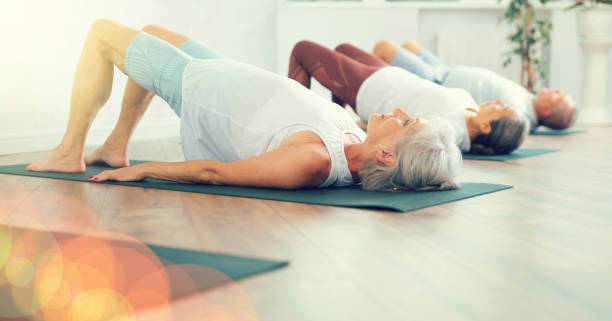Workouts
Are Kegel Exercises Really Harmful for Seniors?
Are Kegel exercises hazardous to seniors? This is a common question among older persons seeking to enhance their pelvic floor health. Kegel exercises, which include tightening and relaxing the muscles that control urine, can be extremely beneficial to people of all ages. However, it is critical to address the concerns and potential hazards involved with this exercise, particularly among seniors. In this article, we will go over the matter in depth and give you a thorough grasp of whether Kegel exercises are hazardous or safe for seniors.
What are Kegel exercises?
Kegel exercises, named after Dr. Arnold Kegel, who first developed them in the 1940s, are a set of exercises for strengthening the pelvic floor muscles. These muscles support the bladder, uterus, and rectum and play an important role in urine and gastrointestinal function. The exercises involve repetitive contraction and relaxation of the pelvic floor muscles.
The beauty of Kegel exercises is that they may be performed anywhere and at any time, without anyone noticing. They require no special equipment and can be done sitting, standing, or lying down. Kegel exercises aim to enhance muscle tone and strength, which can help prevent or treat urine incontinence and other pelvic floor disorders.
According to studies, frequent Kegel exercises can considerably enhance pelvic floor function and reduce the frequency and severity of urine incontinence in both men and women. These exercises can also be advantageous to seniors since they improve bladder control, lower the danger of inadvertent leaking, and may increase sexual satisfaction.

Benefits of Kegel exercises for seniors
Seniors can reap numerous benefits from adopting Kegel exercises into their regular routine. Here are some of the main advantages:
- Improved bladder control: Age-related alterations in the pelvic floor muscles can cause urine incontinence in seniors. Kegel exercises can strengthen these muscles, resulting in improved bladder function and fewer leaks or accidents.
- Prevention of pelvic organ prolapse: Pelvic organ prolapse occurs when pelvic organs, such as the bladder or uterus, enter the vaginal canal. Weak pelvic floor muscles may contribute to this issue. Regular Kegel exercises can assist to strengthen these muscles and potentially lower the risk of pelvic organ prolapse.
- Enhanced sexual health: Strong pelvic floor muscles are required for sexual function in both men and women. Kegel exercises can improve seniors’ sexual feeling and enjoyment by enhancing muscle tone and blood flow to the pelvic area.
Common misconceptions about Kegel exercises for seniors
Despite the numerous benefits, there are a few misconceptions surrounding Kegel exercises for seniors. Let’s address some of these misconceptions and provide clarity:
- Kegel exercises are solely for women: Although Kegel exercises are commonly associated with women, they can be as beneficial to men. Men can also develop urine incontinence and weakening pelvic floor muscles as they age, making Kegel exercises an effective tool for improving bladder control.
- Kegel exercises are only for those with existing pelvic floor issues: Kegel exercises are not limited to people who have pelvic floor disorders. They can benefit all seniors by maintaining and strengthening the pelvic floor muscles, which normally deteriorate with age.
- Kegel exercises are too difficult or time-consuming for seniors: Seniors find Kegel exercises too difficult or time-consuming. Kegel exercises are easy and can be readily integrated into a senior’s regular regimen. They can be done in small bursts throughout the day or while doing routine tasks like watching TV or standing in line. With practice, Kegel exercises become second nature.

How to do Kegel exercises correctly
Performing Kegel exercises correctly is essential to reap their full benefits. Here’s a step-by-step guide on how to do Kegel exercises correctly:
- Identify the correct muscles: The first step is to determine which muscles need to be targeted. Assume you’re attempting to stop the flow of urine or avoid passing gas. The muscles that contract in these instances are the pelvic floor muscles.
- Contract the muscles: After identifying the relevant muscles, squeeze them as tightly as possible without straining. Take cautious not to engage any other muscles, such as those in the abdomen or buttocks.
- Relax the muscles: After the contraction, allow the muscles to rest for 5 seconds. This concludes one Kegel exercise repetition.
- Repeat and increase: Begin with 10 repetitions three times per day. As you get more comfortable, progressively increase the length of each contraction and the amount of repetitions. Aim to progress to 10-second contractions, with a total of 30 repetitions per day.
Remember to breathe normally throughout the exercise and avoid holding your breath. It’s important to note that Kegel exercises may take time and practice to master, so be patient and consistent with your routine.
Precautions and considerations for seniors doing Kegel exercises
While Kegel exercises are generally safe for seniors, there are a few precautions and considerations they should keep in mind:
- Consult with a healthcare provider: Before beginning any new fitness routine, it is always a good idea to consult with a healthcare practitioner, especially if you have any underlying medical ailments or concerns. They can offer personalized advice and guarantee that Kegel exercises are suitable for you.
- Start gently and gradually: If you are new to Kegel exercises or have weak pelvic floor muscles, begin with shorter contractions and fewer repetitions. Overdoing it can result in muscle fatigue or pain. Gradually increase the intensity and duration of your workouts as your muscles strengthen.
- Avoid strain or excessive force: While it is vital to engage the pelvic floor muscles during Kegel exercises, avoid straining or applying too much force. Overexertion might result in muscle tension or discomfort. Concentrate on regulated contractions and relaxations.
- Adjust for individual abilities: Traditional Kegel exercises may be difficult for seniors with mobility concerns or physical restrictions to execute. In such circumstances, modified workouts or assistance equipment, such as biofeedback machines or vaginal weights, can be employed to effectively target the pelvic floor muscles.
By taking these precautions and considering individual abilities, seniors can safely incorporate Kegel exercises into their routine and reap the benefits they offer.

Alternative exercises for seniors with mobility issues
Seniors with mobility issues or physical limitations may find it challenging to perform traditional Kegel exercises. However, there are alternative exercises that can help strengthen the pelvic floor muscles effectively. Here are a few options:
- Bridge pose: Lie on your back with your knees bent and feet flat on the floor. Slowly lift your hips off the ground, engaging your glutes and pelvic floor muscles. Hold for a few seconds, then lower your hips back down. Repeat 10 times.
- Squats: Stand with your feet shoulder-width apart. Slowly lower yourself into a squat position, keeping your back straight and your knees aligned with your toes. Engage your pelvic floor muscles as you lower and rise. Repeat 10 times.
- Modified Kegel exercises: If traditional Kegel exercises are too challenging, try modified versions. For example, instead of contracting and relaxing for 5 seconds, start with shorter durations, such as 2 seconds, and gradually increase as your muscles strengthen.
Remember to listen to your body and adjust the exercises to your abilities. If you experience any pain or discomfort, stop the exercise and consult with a healthcare professional.
Tips for incorporating Kegel exercises into a senior’s daily routine
Incorporating Kegel exercises into a senior’s daily routine can help ensure consistency and maximize the benefits. Here are some tips to make Kegel exercises a regular part of your day:
- Consult with a healthcare provider: Before beginning any new fitness routine, it is always a good idea to consult with a healthcare practitioner, especially if you have any underlying medical ailments or concerns. They can offer personalized advice and guarantee that Kegel exercises are suitable for you.
- Start gently and gradually: If you are new to Kegel exercises or have weak pelvic floor muscles, begin with shorter contractions and fewer repetitions. Overdoing it can result in muscle fatigue or pain. Gradually increase the intensity and duration of your workouts as your muscles strengthen.
- Avoid strain or excessive force: While it is vital to engage the pelvic floor muscles during Kegel exercises, avoid straining or applying too much force. Overexertion might result in muscle tension or discomfort. Concentrate on regulated contractions and relaxations.
- Adjust for individual abilities: Traditional Kegel exercises may be difficult for seniors with mobility concerns or physical restrictions to execute. In such circumstances, modified workouts or assistance equipment, such as biofeedback machines or vaginal weights, can be employed to effectively target the pelvic floor muscles.
By incorporating these tips, you can seamlessly integrate Kegel exercises into your daily routine and make pelvic floor health a priority.
When to seek medical advice for Kegel exercises
While Kegel exercises are generally safe for seniors, there may be instances where medical advice or intervention is necessary. Here are a few situations where seeking medical advice is recommended:
- Persistent pain or discomfort: If you experience persistent pain or discomfort during or after performing Kegel exercises, it’s important to consult with a healthcare professional. They can evaluate your technique, provide guidance, and rule out any underlying issues.
- No improvement in symptoms: If you’ve been consistently performing Kegel exercises for several weeks or months and have not noticed any improvement in your symptoms, it’s advisable to seek medical advice. A healthcare professional can assess your condition and provide alternative treatment options if necessary.
- Incontinence worsens: If your urinary incontinence worsens or you develop new symptoms after starting Kegel exercises, it’s important to consult with a healthcare professional. They can help determine the cause of the worsening symptoms and recommend appropriate interventions.
Remember that healthcare professionals are the best source of personalized advice and guidance. If you have any concerns or questions regarding Kegel exercises, don’t hesitate to reach out to them.

Resources and tools for seniors interested in Kegel exercises
If you’re a senior interested in incorporating Kegel exercises into your routine, there are several resources and tools available to help you get started:
- Online tutorials: There are numerous online tutorials and videos that demonstrate proper Kegel exercise technique. These resources can guide you through the exercises and provide visual cues for correct form.
- Mobile apps: There are several mobile apps specifically designed to help individuals track and perform Kegel exercises. These apps often include reminders, progress tracking, and guided exercises to ensure optimal performance.
- Pelvic floor physical therapists: Pelvic floor physical therapists are specialized healthcare professionals who can provide personalized guidance and treatment for pelvic floor issues. They can assess your condition, teach you proper Kegel exercise technique, and recommend additional exercises or treatments if necessary.
- Support groups: Joining support groups or online forums focused on pelvic floor health can provide valuable information, tips, and support from individuals who have similar experiences. These communities can be a great source of motivation and encouragement.
By utilizing these resources and tools, you can enhance your understanding of Kegel exercises and ensure that you’re performing them correctly and effectively.
Conclusion
In conclusion, Kegel exercises can be extremely beneficial for seniors who want to improve their pelvic floor health. While Kegel exercises are generally safe, seniors should proceed with caution and obtain appropriate supervision from healthcare specialists. Seniors who execute Kegel exercises correctly can strengthen their pelvic floor muscles, improve bladder control, and even improve their general quality of life.
Remember to start cautiously, listen to your body, and seek medical help if necessary. Kegel exercises, when done consistently and patiently, can be an important part of a senior’s daily routine, boosting pelvic floor health and wellbeing. So, don’t hesitate to give them a shot and reap the rewards. Your pelvic floor will appreciate you.
Trusted Health, Wellness, and Medical advice for your well-being


